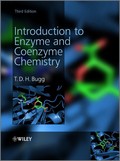Introduction to Enzyme and Coenzyme Chemistry

3. Auflage Juli 2012
290 Seiten, Hardcover
Wiley & Sons Ltd
Kurzbeschreibung
Looking at enzymes from an organic chemistry perspective, this updated reference includes information on recent advances in our understanding of enzyme action; topical examples to illustrate key points; two-color figures of the active sites of enzymes discussed in the text to illustrate the interplay between enzyme structure and function; and end-of-chapter problems to allow readers to check their understanding of the material. This concise but comprehensive guide is essential for undergraduate and postgraduate students of organic, bio-organic, and medicinal chemistry, chemical biology, biochemistry, and biotechnology.
Looking at enzymes from an organic chemistry perspective, this updated reference includes information on recent advances in our understanding of enzyme action; topical examples to illustrate key points; two-color figures of the active sites of enzymes discussed in the text to illustrate the interplay between enzyme structure and function; and end-of-chapter problems to allow readers to check their understanding of the material. This concise but comprehensive guide is essential for undergraduate and postgraduate students of organic, bio-organic, and medicinal chemistry, chemical biology, biochemistry, and biotechnology.
Representation of Protein Three-Dimensional Structures x
1 From Jack Beans to Designer Genes 1
1.1 Introduction 1
1.2 The discovery of enzymes 1
1.3 The discovery of coenzymes 3
1.4 The commercial importance of enzymes in biosynthesis and biotechnology 3
1.5 The importance of enzymes as targets for drug discovery 6
2 All Enzymes Are Proteins 7
2.1 Introduction 7
2.2 The structures of the L-alpha-amino acids 7
2.3 The primary structure of polypeptides 9
2.4 Alignment of amino acid sequences 11
2.5 Secondary structures found in proteins 12
2.6 The folded tertiary structure of proteins 15
2.7 Enzyme structure and function 17
2.8 Metallo-enzymes 20
2.9 Membrane-associated enzymes 21
2.10 Glycoproteins 23
3 Enzymes Are Wonderful Catalysts 26
3.1 Introduction 26
3.2 A thermodynamic model of catalysis 28
3.3 Proximity effects 30
3.4 The importance of transition state stabilisation 32
3.5 Acid/base catalysis in enzymatic reactions 36
3.6 Nucleophilic catalysis in enzymatic reactions 40
3.7 The use of strain energy in enzyme catalysis 44
3.8 Desolvation of substrate and active site nucleophiles 45
3.9 Catalytic perfection 46
3.10 The involvement of protein dynamics in enzyme catalysis 47
4 Methods for Studying Enzymatic Reactions 50
4.1 Introduction 50
4.2 Enzyme purification 50
4.3 Enzyme kinetics 52
4.4 The stereochemical course of an enzymatic reaction 59
4.5 The existence of intermediates in enzymatic reactions 64
4.6 Analysis of transition states in enzymatic reactions 68
4.7 Determination of active site catalytic groups 71
5 Hydrolytic and Group Transfer Enzymes 77
5.1 Introduction 77
5.2 The peptidases 79
CASE STUDY: HIV-1 protease 90
5.3 Esterases and lipases 92
5.4 Acyl transfer reactions in biosynthesis (coenzyme A) 93
5.5 Enzymatic phosphoryl transfer reactions 95
5.6 Adenosine 5'-triphosphate (ATP) 101
5.7 Enzymatic glycosyl transfer reactions 102
5.8 Methyl group transfer: use of S-adenosyl methionine and tetrahydrofolate
coenzymes for one-carbon transfers 107
6 Enzymatic Redox Chemistry 115
6.1 Introduction 115
6.2 Nicotinamide adenine dinucleotide-dependent dehydrogenases 117
6.3 Flavin-dependent dehydrogenases and oxidases 122
6.4 Flavin-dependent mono-oxygenases 128
6.5 CASE STUDY: Glutathione and trypanothione reductases 129
6.6 Deazaflavins and pterins 133
6.7 Iron-sulphur clusters 135
6.8 Metal-dependent mono-oxygenases 136
6.9 alpha-Ketoglutarate-dependent dioxygenases 140
6.10 Non-heme iron-dependent dioxygenases 141
7 Enzymatic Carbon-Carbon Bond Formation 148
7.1 Introduction 148
Carbon-carbon bond formation via carbanion equivalents 149
7.2 Aldolases 149
CASE STUDY: Fructose 1,6-bisphosphate aldolase 150
7.3 Claisen enzymes 153
7.4 Assembly of fatty acids and polyketides 156
7.5 Carboxylases: Use of biotin 158
7.6 Ribulose bisphosphate carboxylase/oxygenase (Rubisco) 161
7.7 Vitamin K-dependent carboxylase 163
7.8 Thiamine pyrophosphate-dependent enzymes 165
Carbon-carbon bond formation via carbocation intermediates 168
7.9 Terpene cyclases 168
Carbon-carbon formation through radical intermediates 173
7.10 Phenolic radical couplings 173
8 Enzymatic Addition/Elimination Reactions 181
8.1 Introduction 181
8.2 Hydratases and dehydratases 182
8.3 Ammonia lyases 187
8.4 Elimination of phosphate and pyrophosphate 190
8.5 CASE STUDY: 5-Enolpyruvyl shikimate 3-phosphate (EPSP) synthase 191
9 Enzymatic Transformations of Amino Acids 197
9.1 Introduction 197
9.2 Pyridoxal 5'-phosphate-dependent reactions at the alpha-position 197
9.3 CASE STUDY: Aspartate aminotransferase 201
9.4 Reactions at the ß- and gamma-positions of amino acids 204
9.5 Serine hydroxymethyltransferase 206
9.6 N-Pyruvoyl-dependent amino acid decarboxylases 208
9.7 Imines and enamines in alkaloid biosynthesis 208
10 Isomerases 213
10.1 Introduction 213
10.2 Cofactor-independent racemases and epimerases 213
10.3 Keto-enol tautomerases 216
10.4 Allylic isomerases 217
10.5 CASE STUDY: Chorismate mutase 219
11 Radicals in Enzyme Catalysis 225
11.1 Introduction 225
11.2 Vitamin B12-dependent rearrangements 225
11.3 The involvement of protein radicals in enzyme catalysis 229
11.4 S-adenosyl-methionine-dependent radical reactions 232
11.5 Biotin synthase and sulphur insertion reactions 233
11.6 Radical chemistry in DNA repair enzymes 234
11.7 Oxidised amino acid cofactors and quinoproteins 238
12 Non-Enzymatic Biological Catalysis 242
12.1 Introduction 242
12.2 Catalytic RNA 242
12.3 Catalytic antibodies 246
12.4 Synthetic enzyme models 251
Appendix 1: Cahn-Ingold-Prelog Rule for Stereochemical Nomenclature 258
Appendix 2: Amino Acid Abbreviations 260
Appendix 3: A Simple Demonstration of Enzyme Catalysis 261
Appendix 4: Answers to Problems 263
Index 271


